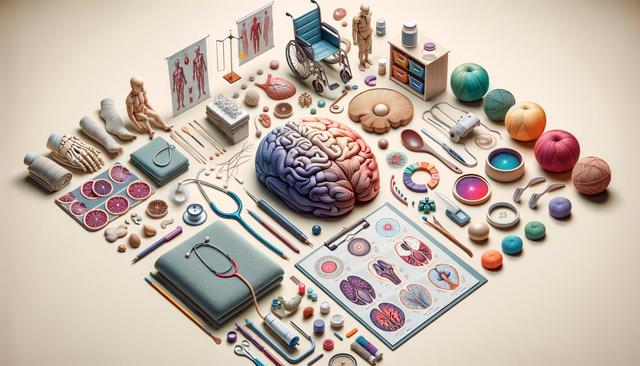Understanding Stroke and Its Impact
A stroke occurs when the blood supply to part of the brain is interrupted or reduced, preventing brain tissue from getting oxygen and nutrients. This can lead to damage in areas of the brain responsible for movement, speech, memory, and other vital functions. The impact of a stroke varies widely depending on the severity and location of the blockage or bleed. Some individuals may face temporary challenges, while others experience long-term or permanent disabilities. Understanding the nature of stroke is the first step in tailoring effective therapy strategies that address the unique needs of each patient.
There are two primary types of strokes: ischemic, caused by a blockage, and hemorrhagic, caused by bleeding in the brain. Each type requires a different approach to immediate treatment and rehabilitation. Stroke therapy generally begins as soon as the individual is medically stable, often within days of the incident. Early intervention is crucial to maximize recovery potential, as the brain is most adaptable during the initial weeks following a stroke. During this time, targeted therapeutic interventions can help retrain the brain and body to function more effectively.
Physical Rehabilitation and Motor Recovery
Physical rehabilitation is a cornerstone of stroke therapy, focusing on regaining strength, coordination, and mobility. Stroke often leads to partial paralysis or motor impairments, particularly on one side of the body. A comprehensive physical therapy program typically includes:
- Strength and endurance training
- Balance and coordination exercises
- Functional mobility tasks such as walking, transferring, and stair climbing
Therapists may use tools like resistance bands, treadmills, and robotic-assisted devices to support movement and encourage muscle reactivation. Regular physical therapy not only helps restore physical function but also reduces the risk of complications such as joint stiffness and muscle atrophy. For some individuals, adaptive devices like braces or canes may be introduced to aid mobility and independence.
Consistency and repetition are key in motor recovery. The brain’s ability to form new neural connections, a process known as neuroplasticity, enables patients to relearn lost motor skills. Therapists often set short- and long-term goals to track progress and maintain motivation. Patients and caregivers play a vital role in continuing exercises at home, reinforcing the benefits of in-clinic therapy sessions.
Speech and Language Therapy
A stroke can significantly affect communication abilities, particularly if the damage occurs in the brain’s language centers. Speech-language pathologists (SLPs) assess and treat speech disorders, language comprehension issues, and problems with reading and writing. Common conditions addressed in stroke therapy include:
- Aphasia – difficulty understanding or producing language
- Dysarthria – slurred or slow speech due to muscle weakness
- Apraxia – difficulty planning and coordinating the movements needed for speech
Therapy sessions are personalized to the individual’s needs and may involve exercises to improve articulation, language drills, and techniques to enhance cognitive-communication skills. In some cases, alternative communication methods such as picture boards or speech-generating devices are introduced to support interaction and social participation.
Effective speech therapy also includes educating family members and caregivers on how to support communication at home. This collaborative approach fosters an encouraging environment that promotes continued progress. Like other forms of rehabilitation, early and sustained intervention in speech therapy can significantly influence outcomes and quality of life.
Occupational Therapy and Daily Living Skills
Occupational therapy (OT) focuses on helping stroke survivors regain the ability to perform everyday tasks. This includes personal care activities such as bathing, dressing, and eating, as well as more complex tasks like managing finances or returning to work. An occupational therapist evaluates the individual’s physical, cognitive, and emotional challenges to develop a tailored intervention plan.
Stroke therapy through OT may include:
- Fine motor skills training (e.g., hand exercises for buttoning shirts)
- Visual-perceptual skill development
- Home environment modifications
- Energy conservation techniques
Therapists also work on compensatory strategies, such as using the non-dominant hand for writing or incorporating assistive tools like adaptive utensils. The goal is to enhance independence and improve overall quality of life. In addition to functional training, OTs may address emotional and psychological well-being, helping patients adjust to new routines and limitations.
Occupational therapy is particularly effective when started early and integrated with other rehabilitation efforts. It encourages patients to actively participate in their recovery, fostering a sense of achievement and autonomy. Regular assessments help track improvements and adapt goals to meet changing abilities.
Cognitive and Emotional Support
Stroke often affects more than just physical and speech functions; it can also impact memory, attention, problem-solving, and emotional health. Cognitive rehabilitation involves structured activities designed to strengthen mental processes. Therapists may use computer-based programs, memory aids, and task-specific training to enhance cognitive performance.
Mental health is another critical component of stroke therapy. Many survivors experience depression, anxiety, or mood swings as they adjust to life after stroke. Addressing these emotional challenges is essential for holistic recovery. Support may include:
- Counseling or psychotherapy
- Medication management
- Participation in stroke support groups
- Mindfulness and stress-reduction techniques
Family involvement is beneficial in recognizing changes in mood or behavior and ensuring the individual receives appropriate care. A multidisciplinary team approach that includes neuropsychologists, counselors, and social workers can offer comprehensive support tailored to each patient’s needs.
The integration of cognitive and emotional support within stroke therapy helps improve adherence to rehabilitation, enhances motivation, and contributes to long-term recovery success. Encouraging open communication and providing access to mental health resources should be a standard part of post-stroke care.
Conclusion: A Path Forward in Stroke Recovery
Effective stroke therapy requires a multifaceted approach that addresses the physical, communicative, cognitive, and emotional challenges faced by survivors. Early intervention, consistency, and individualized care plans are key factors in supporting recovery and enhancing quality of life. Whether through physical rehabilitation, speech therapy, occupational tasks, or emotional support, each element plays a vital role in the healing journey.
For individuals recovering from a stroke and their families, understanding the available therapies and participating actively in the process can make a profound difference. With a coordinated team of healthcare professionals and a strong support system, many stroke survivors can regain significant levels of function and independence. Exploring effective stroke therapy is not just about treatment—it’s about building a meaningful path to recovery.








